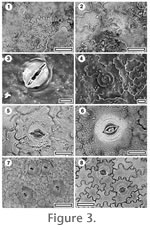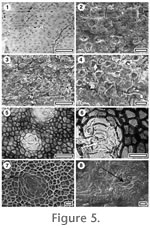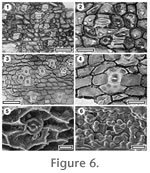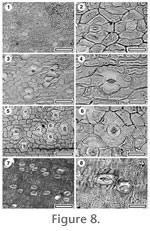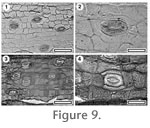|
|
APPENDIX 1. KEY TO MONOCOT CUTICLE WITH ALIGNED STOMATES1. Stomatal complexes not visible under TLM 2. 2. Papillae or glandular trichomes present 3. 3. Glandular trichomes appear in pairs amongst normal epidermal cells CUT-Mo-EFE. 4. Epidermal cells not in clear files CUT-Mo-FEH. 5. Papillae present 6. 6. Papillae small and essentially restricted to the epidermal cells CUT-Mo-FJC. 7. Papillae mostly restricted to the subsidiary cells CUT-Mo-FFJ. 8. Papillae on subsidiary cells overarch stomatal pore 9. 9. Papillae smooth and discrete CUT-Mo-FJE. 10. Stomatal complexes distinctly straight-sided CUT-Mo-EFI. 11. Papillae high and distinct CUT-Mo-EIA. 12. Stomatal complexes in well-defined zones 13. 13. Stomatal complexes in broad zones separated by narrow non-stomatal zones CUT-Mo-EHB. 14. Stomata typically elliptical, without prominent arching lateral subsidiary cells CUT-Mo-FFA. 15. Stomatal complexes uncommon, epidermal cells isodiametric or shorter than broad CUT-Mo-EII. CUT-Mo-EEI (Rhipogonum sp.)
Referred specimens and occurrence: SL1709, Sthd-019; SL2035, Sthd-046. Referred specimens and occurrence: Epidermis not divided into costal and intercostal zones (stomata evenly spread). Stomatal complex construction apparently paracytic, although subsidiary cells not clearly staining more than normal epidermal cells, not in rows, randomly oriented, stomata circular, but not clearly outlined, diameter 14-23 Ám (medium). Outer stomatal ledge cuticle markedly thicker than normal epidermal cells, broad in centre and narrowing distinctly toward the ends, with slit-like, elongate aperture. Subsidiary cells each with a single arching ridge of cuticle (Figure 3.3), following the guard cells, but not meeting at the poles. Epidermal cells clearly visible under TLM, isodiametric, sinuous, slightly buttressed, glabrous, not papillate. Identification: Pole (1993b) described Early Miocene leaf impressions from Bannockburn that were indistinguishable from the extant New Zealand Rhipogonum scandens and therefore identified them as the living species. Later, leaves with similar architecture were found with cuticle at the Early Miocene locality of Foulden Hills (Pole 1996). The cuticle details confirmed the identification (but note that figures 11c, d in Pole 1996 inadvertently lack captions. They are of extant Rhipogonum scandens). The specimens in this study are dispersed cuticle only, and without the benefit of leaf architectural a broader range of possibilities must be considered for identification. The Rhipogonaceae and Smilacaceae are two of the "net-veined" monocots (Inamdar et al. 1983) and as such, they do not have stomata and epidermal cells arranged in rows like parallel-veined monocots. However, they both have similar epidermal features which makes them clearly recognisable, although hard to tell from one another. Both have paracytic stomatal complexes where the subsidiary cells are generally slightly thicker than normal epidermal cells, of uneven size, and with an irregular outer wall, and the epidermal cells are highly sinuous. The dispersed fossil material clearly fits this basic morphology. Based on the species available in the extant reference collection (seven species of Rhipogonum and nine of Smilax), in general, Smilax species tend to have thin, or poorly defined epidermal cell anticlinal walls, poorly defined margins to generally elliptical stomata which are 20-35 Ám in greatest diameter (medium-sized). In contrast, Rhipogonum tend to have much stronger or clearly defined epidermal cell anticlinal walls, and well-defined margins to generally circular stomatal which are 28-43 Ám in diameter (from medium to large) (see Figure 3.7-3.8). The new fossil is consistent with Rhipogonum, although there are subtle, but consistent differences with the R. scandens (Figure 3.5). In the fossil, the pair of ridge-arcs flanking the stomata is more prominent, and the stomata are slightly smaller. Without leaf architectural details it is inadvisable to place the dispersed cuticle fragment into an extant species. Very similar cuticle is also present in the Early Eocene of Regatta Point, Tasmania.
Reference specimen: SL1969, Sthd-055. Referred specimens and occurrence: SL1673, Sthd-034; SL1812, Sthd-100. Description. Epidermis not divided into costal and intercostal zones (stomata evenly spread). Stomatal complex construction unclear, in distinct rows, longitudinally oriented. Polar subsidiary cells chained (details indistinct). Subsidiary cells with periclinal walls of same thickness as those of normal epidermal cells, not papillate. Outer stomatal ledge cuticle same thickness as normal epidermal cells. Epidermal cell walls not clearly visible under TLM (cuticle very thin), but probably straight-walled, unbuttressed, glabrous, not papillate.
CUT-Mo-EFE (Astelia sp.)
Referred specimens and occurrence: SL2624, BL-07; SL1567, Sthd-004; SL1726, Sthd-017; SL1668, Sthd-034; SL2071, Sthd-047; SL1918, Sthd-056; SL1882, Sthd-073; SL1911, Sthd-074; SL1830, Sthd-095; SL1646, Sthd-102; SL1626, Sthd-107; SL1600, Sthd-108. Description. Epidermis not divided into costal and intercostal zones. Stomatal complex construction not known. Hirsute, with paired, short, possible uniseriate persistent glandular trichomes. Other epidermal cells clearly visible under TLM (but cuticle thin) in rows, irregularly shaped, straight-walled, unbuttressed, glabrous, non-papillate. Identification. The very distinctive paired glandular trichomes appear to be characteristic of Astelia (Figure 2.7-2.8). No stomatiferous fossil cuticle has been found, perhaps because it was much thinner than the other surface and therefore does not survive processing. CUT-Mo-EFE is also present at Hamilton's Gap, a mid-Pleistocene deposit in the North Island.
CUT-Mo-EFH Referred specimens and occurrence: SL1968, Sthd-055. Referred specimens and occurrence: Epidermis not divided into costal and intercostal zones (stomata evenly spread). Stomatal complex construction unclear. Subsidiary cells with periclinal walls of same thickness as those of normal epidermal cells; papillate, papillae not overarching stomatal pore. Outer stomatal ledge not visible. Epidermal cell walls not clearly visible under TLM, but cells obviously in rows; straight-walled; unbuttressed; glabrous; papillate; each cell with a single smooth papillae.
CUT-Mo-FEH Referred specimens and occurrence: SL3238, Sthd-163. Referred specimens and occurrence: Epidermis not divided into costal and intercostal zones (stomata evenly spread). Stomatal complex construction tricyclic, encyclocytic with 5-7 subsidiary cells, outline circular, not in rows, longitudinally oriented. Polar subsidiary cells widely spaced. Subsidiary cells with periclinal walls thinner than those of normal epidermal cells, not papillate. Outer stomatal ledge cuticle thinner than normal epidermal cells, with elongate aperture. Epidermal cells clearly visible under TLM, not in clear rows (but some in short, irregular files), isodiametric, straight-walled, unbuttressed, glabrous, not papillate.
CUT-Mo-FJC
Referred specimens and occurrence: Epidermis divided into costal and intercostal zones (stomata concentrated in zones at least 10 stomatal complexes wide). Stomatal complex construction dicyclic, paratetracytic, typically with four subsidiary cells, outline elongate, in distinct rows, longitudinally oriented. Polar subsidiary cells well-spaced along files (nearest neighbour typically in adjacent file). Subsidiary cells with periclinal walls thinner than those of normal epidermal cells, partially papillate (each subsidiary cell has 0-1 papillae). Outer stomatal ledge cuticle thinner than normal epidermal cells, with slit-like aperture. Epidermal cells clearly visible under TLM, in rows, isodiametric or wider than long, straight-walled, unbuttressed, glabrous, papillate, each cell with 1-3 papillae (very small and round to large and irregular). Epidermal cells of costal zones distinctly more elongate than intercostal cells. Identification. The outer stomatal ledge shape and thin periclinal walls on the subsidiary cells suggest Typha, but as no extant Typha are known to have papillae, the identity of CUT-Mo-FJC remains uncertain.
CUT-Mo-FFJ Referred specimens and occurrence: SL3239, Sthd-163. Referred specimens and occurrence: Epidermis divided into costal and intercostal zones (stomata concentrated in zones). Stomatal zones about 4-6 stomatal complexes wide. Stomatal complex construction dicyclic, paratetracytic, typically with four subsidiary cells, outline irregular - polar subsidiary cells project beyond margin of lateral subsidiary cells. Stomatal complexes in overlapping rows, longitudinally oriented. Polar subsidiary cells well-spaced along files (nearest neighbour typically in adjacent file). Subsidiary cells with periclinal walls thinner than those of normal epidermal cells, papillate, papillae not overarching stomatal pore. (Each subsidiary cell has 1-4 papillae). Outer stomatal ledge cuticle thicker than normal epidermal cells, with slit-like aperture, tapering toward the ends. Epidermal cells clearly visible under TLM, in rows, irregularly shaped, straight-walled, unbuttressed, glabrous, essentially not papillate, but some epidermal cells within stomatal zones, and close to stomata, have papillae, each cell with 1-3 papillae (subdued). Epidermal cells of costal zones slightly elongate. Identification. Possibly Pandanaceae. Compare with illustrations in Tomlinson (1965) and Kam (1971).
CUT-Mo-FJE
Referred specimens and occurrence: SL2424, Sthd-055. Referred specimens and occurrence: Epidermis not divided into costal and intercostal zones (stomata evenly spread). Stomatal complex construction monocyclic, paratetracytic, typically with 4 subsidiary cells, outline irregular - polar subsidiary cells project beyond margin of lateral subsidiary cells. Stomatal complexes in distinct rows, densely packed, with no epidermal cell files in stomatal zone, longitudinally oriented. Polar subsidiary cells well-spaced along files (nearest neighbour typically in adjacent file). Subsidiary cells with periclinal walls of same thickness as those of normal epidermal cells, papillate, papillae thick, expanding to partially obscure the stomatal pore (each subsidiary cell has a single papillae, except when the cell is networked, in which case there is a papillae per networked stomatal complex). Outer stomatal ledge cuticle same thickness as normal epidermal cells, with rectangular aperture (with bowed sides defined by edges off papillae). Epidermal cells clearly visible under TLM, in rows, isodiametric, straight-walled, unbuttressed, glabrous; papillate, each cell with 1-2, thick, smooth papillae. Identification. Possibly Pandanaceae. Compare with illustrations in Tomlinson (1965) and Kam (1971).
CUT-Mo-AAI Referred specimens and occurrence: SB1354, BL-32 Referred specimens and occurrence: SL0106, BL-08; SB0875, GL-01; SL3242, Sthd-163. Referred specimens and occurrence: Epidermis divided into costal and intercostal zones (stomata concentrated in zones). Stomatal zones 2-3 stomatal complexes wide. Stomatal complex construction unclear, paratetracytic, typically with four subsidiary cells, outline unclear, not in rows, longitudinally oriented. Subsidiary cells with periclinal walls of same thickness as those of normal epidermal cells, papillate, papillae expanding to partially obscure the stomatal pore (each subsidiary cell has an indeterminate number of subdued and fused papillae). Outer stomatal ledge cuticle same thickness as normal epidermal cells, with slit-like aperture. Epidermal cells clearly visible under TLM, in rows, elongate, straight-walled, markedly hexagonal and with slightly thickened polar anticlinal walls, unbuttressed, glabrous. Intercostal epidermal cells papillate, each cell has up to five papillae, which are usually fused into a single multi-headed unit, or sometimes as isolated or various fused units. Epidermal cells of costal zones distinctly more elongate than intercostal cells, not papillate. Identification. Possibly Pandanaceae. Compare with illustrations in Tomlinson (1965) and Kam (1971).
CUT-Mo-EFI Referred specimens and occurrence: SL1973, Sthd-055. Referred specimens and occurrence: SL2041, Sthd-076; SL2073, Sthd-113. Referred specimens and occurrence: Epidermis not divided into costal and intercostal zones (stomata evenly spread). Stomatal complex construction monocyclic, paratetracytic, typically with four subsidiary cells, outline irregular, straight-sided, polar subsidiary cells project beyond margin of lateral subsidiary cells, not in rows, longitudinally oriented. Guard cells flanked on the inside by a thick ridge of cuticle. Polar subsidiary cells widely spaced. Subsidiary cells with periclinal walls thinner than those of normal epidermal cells, not papillate. Outer stomatal ledge cuticle thicker than normal epidermal cells, narrowly-elliptic, with elongate, slit-like aperture. Epidermal cells clearly visible under TLM, in rows, elongate, straight-walled, unbuttressed, glabrous, slightly papillate. Identification. Similar cuticle is present in the Early Eocene of Tasmania, but the lateral subsidiary cells, have a more arched appearance, and the thick ridge flanking the guard cells is absent.
CUT-Mo-EIA
Referred specimens and occurrence: SL3241, Sthd-163. Referred specimens and occurrence: Epidermis not divided into costal and intercostal zones (stomata evenly spread). Stomatal complex construction dicyclic, paratetracytic, typically with 4 subsidiary cells, outline irregular - polar subsidiary cells project beyond margin of lateral subsidiary cells, not in rows. Polar subsidiary cells well-spaced along files (nearest neighbour typically in adjacent file). Separated, with one or more purely epidermal cell files within the stomatal zone, longitudinally oriented. Subsidiary cells with periclinal walls of same thickness as those of normal epidermal cells, papillate, papillae not overarching stomatal pore (each subsidiary cell has a single smooth papilla, divided into 1-5 crowns). Outer stomatal ledge cuticle same thickness as normal epidermal cells, with slit-like aperture, tapering towards ends. Epidermal cells clearly visible under TLM, in rows, isodiametric or wider than long, straight-walled, unbuttressed, glabrous, papillate, each cell has up to five papillae, which are usually fused into a single multi-headed unit, or sometimes as isolated or various fused units. Epidermal cells of costal zones distinctly more elongate than intercostal cells. Identification. Possibly Pandanaceae. Compare with illustrations in in Tomlinson (1965) and Kam (1971).
CUT-Mo-FEG Referred specimens and occurrence: SL2093, GL-07. Referred specimens and occurrence: Epidermis divided into costal and intercostal zones (stomata concentrated in zones). Stomatal zones about 10-15 stomatal complexes wide. Stomatal complex construction monocyclic and dicyclic, paratetracytic, typically with four subsidiary cells, outline irregular - polar subsidiary cells project beyond margin of lateral subsidiary cells, not in rows, longitudinally oriented. Polar subsidiary cells well-spaced along files (nearest neighbour typically in adjacent file). Subsidiary cells with periclinal walls thinner than those of normal epidermal cells, papillate, papillae not overarching stomatal pore (each subsidiary cell has an indeterminate number of subdued and fused papillae). Outer stomatal ledge cuticle thicker than normal epidermal cells, with slit-like aperture. Epidermal cells clearly visible under TLM, in rows, straight-walled, unbuttressed, glabrous, papillate, each cell has up to five papillae (smooth), which are usually fused into a single multi-headed unit, or sometimes as isolated or various fused units. Epidermal cells of costal zones distinctly more elongate than intercostal cells. Identification. Possibly Pandanaceae. Compare with illustrations in Tomlinson (1965) and Kam (1971).
CUT-Mo-EHB Referred specimens and occurrence: SL2524, BL-05. Referred specimens and occurrence: SL2036, Sthd-046; SL1541, Sthd-068; SL2078, Sthd-113. Referred specimens and occurrence: Epidermis not regularly divided into costal and intercostal zones (stomata essentially evenly spread). Stomatal complex construction monocyclic and dicyclic, paratetracytic, typically with four subsidiary cells, outline irregular - polar subsidiary cells project beyond margin of lateral subsidiary cells, in overlapping rows, separated, with one or more purely epidermal cell files within the stomatal zone, mainly longitudinally oriented, but with some slightly oblique. Polar subsidiary cells well-spaced along files (nearest neighbour typically in adjacent file). Subsidiary cells with periclinal walls of same thickness as those of normal epidermal cells, not papillate. Outer stomatal ledge cuticle thicker than normal epidermal cells, with slit-like aperture, tapering towards ends. Epidermal cells clearly visible under TLM, in rows, isodiametric or wider than long, wavy-walled, unbuttressed, glabrous, not papillate. Irregular costal zones formed of epidermal cells distinctly more elongate than normal cells.
CUT-Mo-EFF Referred specimens and occurrence: SL1785, Sthd-030. Referred specimens and occurrence: SL1666, Sthd-034; SL1931, Sthd-058. Referred specimens and occurrence: Epidermis divided into costal and intercostal zones (stomata concentrated in zones). Stomatal zones about two stomatal complexes wide. Stomatal complex construction unclear, essentially paratetracytic, but extreme variation in number and shape of subsidiary cells (up to four lateral subsidiary cells on each side), outline elongate, in overlapping rows, separated, with one or more purely epidermal cell files within the stomatal zone, longitudinally oriented. Polar subsidiary cells well-spaced along files (nearest neighbour typically in adjacent file). Subsidiary cells with periclinal walls thicker than those of normal epidermal cells, not papillate. Outer stomatal ledge cuticle thinner than normal epidermal cells, with slit-like aperture. Epidermal cells clearly visible under TLM, in rows, isodiametric, straight-walled, unbuttressed, glabrous, not papillate. Epidermal cells of costal zones isodiametric.
CUT-Mo-FFA (Typha sp.)
Identification. The elongate shape of the subsidiary cells with distinctive, truncate polar ends and the narrow subsidiary cells indicate Typha, although clearly not the common T. orientalis currently in New Zealand (Figures 9.3, 9.4). A further extant species, T. domingensis is shown for comparison. A further extant species, T. domingensis is shown for comparison. Referred specimens and occurrence: Epidermis not divided into clear costal and intercostal zones, although possibly in many narrow zones about two stomatal complexes wide where the stomatal complexes are widely-spaced. Stomatal complex construction dicyclic, paratetracytic, typically with four subsidiary cells, outline elongate, in overlapping rows, mainly longitudinally oriented, but with some slightly oblique. Polar subsidiary cells well-spaced along files (nearest neighbour typically in adjacent file). Subsidiary cells with periclinal walls of same thickness as those of normal epidermal cells, not papillate. Outer stomatal ledge cuticle thicker than normal epidermal cells, with elliptical aperture, flanked on each side by a thin ridge of cuticle. Epidermal cells clearly visible under TLM, in rows, isodiametric, straight-walled, unbuttressed, glabrous, not papillate. Epidermal cells of costal zones slightly elongate.
CUT-Mo-EII
Referred specimens and occurrence: SL3240, Sthd-163; SL1536, Sthd-067. Referred specimens and occurrence: Epidermis not divided into costal and intercostal zones (stomata evenly spread). Stomatal complex construction tricyclic, essentially paratetracytic, but extreme variation in number and shape of subsidiary cells, outline circular, not in rows, longitudinally oriented. Polar subsidiary cells well-spaced along files (nearest neighbour typically in adjacent file). Subsidiary cells with periclinal walls thicker than those of normal epidermal cells, not papillate. Outer stomatal ledge cuticle thicker than normal epidermal cells, aperture rounded. Epidermal cells clearly visible under TLM, in rows, normally elongate, but sometimes several contiguous cells are much shorter than broad (partially formed stomatal complexes?), wavy-walled, unbuttressed, glabrous, not distinctly papillate although outer periclinal walls bulge outwards. Often with some cutinisation of inner periclinal walls.
CUT-Mo-FEF Referred specimens and occurrence: SL3143, GL-01. Referred specimens and occurrence: SL3168, BL-33. Referred specimens and occurrence: Epidermis not divided into costal and intercostal zones (stomata evenly spread). Stomatal complex construction tricylic and dicylic, encyclocytic with 5–7 subsidiary cells, outline circular, not in rows, obliquely oriented. Polar subsidiary cells widely spaced. Subsidiary cells with periclinal walls thicker than those of normal epidermal cells, not papillate. Outer stomatal ledge cuticle thinner than normal epidermal cells, with slit-like aperture, tapering towards ends. Epidermal cells clearly visible under TLM, in rows, irregularly shaped, typically longer than wide, straight-walled, unbuttressed, hirsute. Trichomes common, scattered over leaf, attached over epidermal cell having much thicker periclinal cuticle than normal epidermal cells, unicellular, persistent, not papillate.
Typhaceae
|
